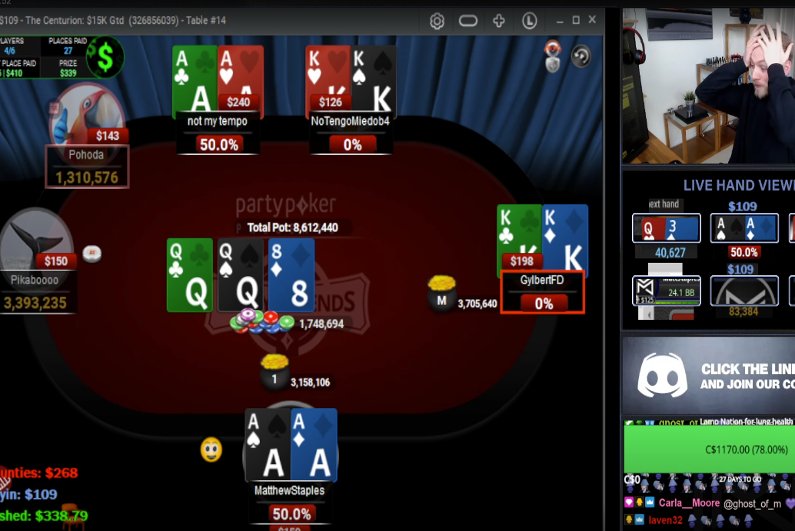The hand in question
Six left in The Centurion, a 15k GTD $109 buyin PKO on partypoker, and it starts routinely enough with under the gun opening for 2.1 big blinds (BBs) off a 35 big blind stack. Next to act quickly shoves for just over 11 big blinds, much to the delight of Twitcher Matt Staples sitting just behind with Aces. He shoves his 24 BBs, and it folds round to the big blind. Covering everyone, he also shoves and now the original opener goes deep into the tank before finally calling it off with Kings. The first shover also has Kings, and the big blind has Aces, so it’s that classic Aces vs. Aces vs. Kings vs. Kings cooler.
in the face of such heavy action, is Kings really a call?
Strategically, the only interesting question about the hand is whether the original opener should call it off with Kings in the face of three shoves. Those shoves are all obviously totally standard but in the face of such heavy action, is Kings really a call?
In these spots you have to try to put your opponent on hand ranges, and assess the equity of your hand against them. This is difficult four-way! It’s also important to remember that four-way, you only need to win 25% of the time (actually slightly less because of dead money in the pot), without taking independent chip model (ICM) into account.
Using Holdem Resources Calculator
There are a number of preflop solvers we can use to look at spots like this, but they all have one problem that is very relevant here. More on that later. I use one called Holdem Resources Calculator (HRC), and talk you through the setup in the accompanying video:
Before going into that, let’s just think about the ranges, starting with the first shover. He’s facing an under the gun open, but he has 11 big blinds so he has to go with anything decent. As it’s a PKO and everyone covers him, he can actually go a little wider because he will be called wider by players chasing his bounty. He can expect even moderately strong hands such as medium pocket pairs to be ahead more often.
bounty considerations trump ICM early in PKO tournaments
Matt’s range is going to be a lot tighter, because he’s risking a lot more. Yes, he can win the bounty, but that’s not a massive factor at this point. As I explain in my book “PKO Poker Strategy,” bounty considerations trump ICM early in PKO tournaments and you should widen your ranges considerably to aggressively target bounties. By the time you reach the final table however, it flips, and ICM considerations tend to overshadow bounties.
How tight should the big blind be? He covers everyone and can win all the bounties. Because of that, I think a lot of players get these spots very wrong. Blinded by bounty lust, they think they should widen their ranges considerably to try to capture them, but as I said, at this stage of a PKO, ICM is much more important. So I suspect the big blind has to be very tight here.
Now it’s back on the opener who probably wasn’t expecting this outcome when he nonchalantly clicked the 2.1BB open button. It’s four-way, so the breakeven point is just under 25% equity when we consider the dead money. He’s also invested a few BBs already, which drags it down. He can win a bounty against the shover with the widest range, which drags it down a few more percentage points. In “PKO Poker Strategy” there’s an entire chapter on concepts I call bounty factor and bounty discount you can use to estimate exactly how many percentage points, in game.
The solution and the problem
In the accompanying video, I talk through the setup needed in HRC. We enter all the stacks, blinds and bounties, the prize pool, and we specify that it’s a PKO with ICM considerations. We also specify open and three-bet sizes, and then we are good to go.
Once the sim has run, we can start looking at the ranges. The opener’s range is the least exciting, a fairly standard UTG opening range six-handed. The first shover’s range, as suspected, is anything decent: 88+ AQ+.
solvers can only calculate perfect GTO ranges for two players
Matt’s range as noted above is tighter: TT+ AK. So far so good, but now we hit that problem I mentioned before. From a game theory point of view, solvers can only calculate perfect game theory optimal (GTO) ranges for two players. To go beyond that, it has to make simplifications, abstractions, and assumptions, and beyond a certain point that ceases to be useful (and/or too difficult to compute).
We have now reached that point in the hand: the solver can offer a reasonable guess at the opener’s calling range if folded back to him, but that’s it. It can’t assess the over-call ranges of the remaining players, which we really need, as obviously there’s quite a difference between what the opener should call facing a big blind shove, to that if it’s just folded back to him.
Applying the hack
I started my working life as an electronic engineer. Engineers are not purists or perfectionists like lab scientists. We are a practical bunch and one thing we learn early is not all problems can be solved perfectly. If you’re faced with a problem you can’t solve, all you can do is solve the closest one to it that has a solution. In this case, the hack starts by ignoring the opener and rearranging the seats at the table. If we move everyone one seat to the right, the original opener is now the big blind, and the first shover is under the gun.
I did this and ran the sim again. This produced a shoving range for UTG, a reshove range for Matt, and the big blind. But wait; there’s a problem. Actually there are two. Firstly, the solver still can’t come up with the call-off range for the fourth player in the hand (the original opener, shifted to the big blind in this sim so he’s last to act). Secondly, the range for the first shover will be significantly different because it’s a very different situation. And because his range is different, that makes the other two computed ranges off.
the sim confirmed this: the range is QQ+ AKs
I solved this second problem by copying the ranges for the original shover and Matt from the first sim to the second sim, locking them, and recalculating the big blind range. As noted above, I expected the big blind’s range had to be super tight even though he covers everyone, and the sim confirmed this: the range is QQ+ AKs.
Now that we have solved for the first three ranges, we can work out the call-off range from first principles simply by working out the equity of KK against the other three ranges. As noted above, considering that it’s four-way, and there’s dead money and bounties, the breakeven equity is probably somewhere around 18% or 19% not taking ICM into account. ICM drags it back up a couple of points.
I used an equity calculator called Odds Oracle to confirm that Kings comfortably exceeds this point: it actually has over 30%. In the accompanying video. I looked at a few other hands to work out the call-off range.
What is the conclusion?
Kings is a very clear call. While there’s some margin of error introduced by the simplifications and assumptions we had to make to get a solution, it clearly isn’t even close. What about Queens? It turns out Queens is in or around the break-even point (it’s probably a fold when we take ICM into account). That obviously means Jacks and down are clear folds.
What about Ace-King? People often overvalue this hand multi-way, seduced by its blockers and equity against everything it doesn’t block, but the reality is the hand performs very poorly multi-way. In this specific example, it only has 14%, so it’s a very clear fold.
The board ran out with no drama and the Aces chopped as they almost always will. The Kings aren’t completely dead, but they are drawing very thin to a chop with a king-high straight on a board where there aren’t four cards to a flush.
Each pair of Kings can even scoop the pot once in a blue moon. Can you see how? That’s right: they can hit a King-high straight flush. In almost all other cases the Aces will chop, except on four flush boards, in which cases one of them scoops, unless one of the Kings hits a straight flush.




